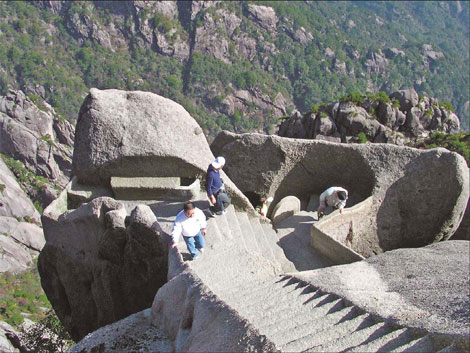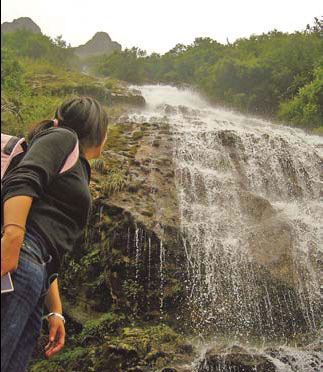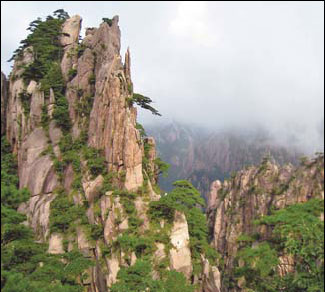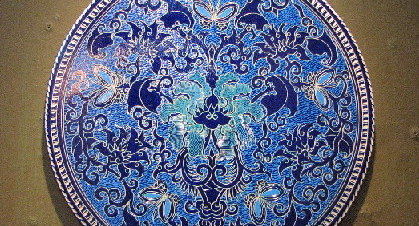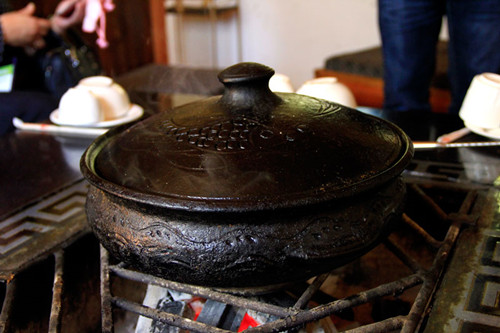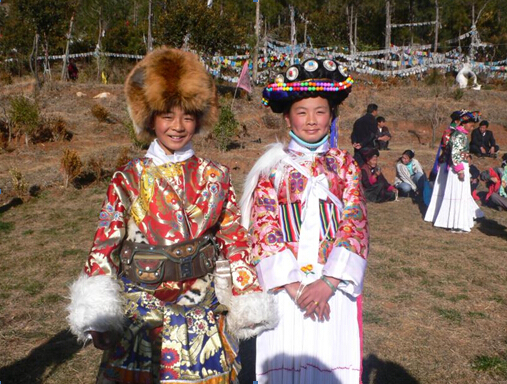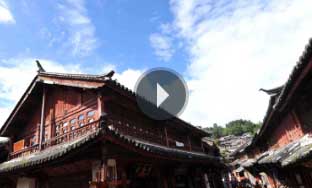Leap of adventure
(China Daily)
|
Tourists climb the steps up Huangshan, in southern Anhui province. Catherine Tsai / Associated Press |
Two geologic wonders far from the urban crowd offer scenery, exhilaration and adrenaline, as Suzanne Ma reports
For first-time visitors to China, Beijing and Shanghai are the default destinations. But for tourists who like to mix city travel with outdoor adventure, two natural landmarks stand out - Yellow Mountain and Tiger Leaping Gorge. Both are among the country's most popular attractions. Yellow Mountain, or Huangshan, has been an icon in Chinese culture for centuries. Tiger Leaping Gorge in Yunnan province ranks among the deepest gorges in the world.
Yellow Mountain
Standing amid billowing clouds high atop Yellow Mountain, you will want to reach out and grasp the silvery wisps in front of you.
Then the clouds part to reveal a stunning mountain range of yellow granite ranging as far as the eye can see. A moment later, the scene changes once again as clouds drift on to reveal a canyon filled with a sea of peaks. The peculiar crests jut out amid smooth boulders. Tall Chinese pines appear rooted in the rocks.
Although the name Huangshan, which means Yellow Mountain, suggests a single mountain, it is actually a range that spans 150 square kilometers in southern Anhui province 480 kilometers southwest of Shanghai. Set aside at least two days for a visit.
|
A tourist looks up at a cascading waterfall along a rocky trail in Yunnan's Tiger Leaping Gorge. Mark Kuo / Associated Press |
The cliffs were formed 100 million years ago when an ancient sea disappeared. During the Ice Age, glaciers carved out more than 70 remarkable peaks. The scenery has long inspired poets and painters.
The hiker can follow one of two routes up: the western steps - a longer hike with spectacular views - or the eastern steps, which are shorter and scenic but not as striking. Either can be done on a daylong hike or by cable car (80 yuan, about $12).
I rode up the eastern cableway with my baby boomer parents. The new cable cars built in Switzerland are efficient, but during the summer months, you may have to line up with annoying tour groups and their megaphone-wielding guides.
On foot, the climb can be a painful pilgrimage. On a different trip with friends, I endured a nine-hour hike up the western steps, stayed overnight at a hotel at the summit, then withstood a nine-hour trek down the eastern steps the next day. I found myself at times already breathless while trying to admire breathtaking views. Make sure to bring clothing appropriate for the season -freezing temperatures in winter, rainy summers - and buy a wooden walking stick at the base of the mountain for 10 yuan. Your knees will thank you later.
While physically challenging, the hike is straightforward logistically. Over the years, tens of thousands of stone steps have been carved into the side of the mountains allowing for a steady, safe climb.
There are well-signed maps, public toilets and snack bars along the way. En route, you will have to sidestep your way around porters who carry food and supplies to the hotels, balancing cargo on long poles on their shoulders and backs. If you can't carry your own pack up, you can pay a porter to help you. You can even hire a porter to carry you up for 430 yuan.
|
Yellow Mountain is actually an entire mountain range spanning 150 square kilometers in southern Anhui province. Suzanne Ma / Associated Press |
Keep an eye out for rocks and trees with peculiar names as described by signs that include English translations - Flower Blooming on a Brush Tip, Welcoming Guest Pine and Mobile Phone Rock. Make sure you get the chance to tiptoe across Aoyu Bei - or Carp's Backbone - a very narrow 9-meter arch with sheer drops on both sides.
Stay at least one night at the summit 1,890 meters above sea level and wake up to watch the sunrise at 4:30 am. Huangshan's best-kept secret may be the secluded 9.5-kilometer hike down the Xihai - West Sea - Grand Canyon. The circular four-hour route is only for the physically fit, taking you down steps, up mountain trails, over bridges and through tunnels. Tour groups do not come down this way, though, so it offers awesome views without crowds.
Many English-language websites can help you plan a trip, including http://bit.ly/dUI4qX and http://bit.ly/dFIjus. Buses from Tangkou, the town at the base of Huang Shan, run daily to and from major cities including Nanjing, Hangzhou, Shanghai and Wuhan. From Tangkou, you can take a shuttle bus to the mountain entrance.
Hotels can be found in five places on the mountain. Prices and availability vary by season; book ahead. Entrance fees to the mountain are 200 yuan for adults and 60 yuan for students, seniors and children.
Tiger Leaping Gorge
As you hike Tiger Leaping Gorge, you will breathe crisp air under a high-altitude sun, gaze at snowcapped mountains in the distance and hear the churning, wild waters of the river somewhere down below. You probably will step in donkey manure, too.
This is a frontier adventure, after all, and a little donkey dung was not going to stop me, not even on the infamous 24-Bend Path, a rough and rocky road that spirals upward before finally reaching flatter terrain.
Local men who rent the donkeys targeted the women in our group, telling us we would be too weak to make it all the way up.
"Don't put yourself through it. Just hop on," they incessantly beckoned. But adrenaline and pride only goaded me forward and before I knew it, I had finished the 24th bend.
I stood 3,960 meters above the Jinsha River, hiked 29 kilometers on a rocky trail past cascading waterfalls and climbed down rugged cliffs on worn but sturdy ladders.
All the while, panoramic views beckoned of majestic green mountains dotted with the humble villages and terraced rice fields of the southwestern province of Yunnan. We came across plenty of goats and oxen in the fields but only a handful of other human beings on the way.
Tucked snugly between the Yulong Snow Mountains in the east and the Haba Snow Mountains in the west, the gorge is named for a tiger that is said to have escaped humans by leaping across the fierce waters where the canyon narrows.
Extreme caution by hikers is warranted. Half a dozen people have died hiking the dirt trails, which can give way after heavy summer rainfalls. I experienced a near miss by getting too close to the edge while hiking down. The path gave way, and I lost my balance and tumbled about 4.5 meters down the cliff.
I landed precariously in a large bush, the last bit of vegetation before a rocky, vertical drop to the rushing river waters below. My six travel mates scrambled to form a human chain and pulled me up. If you make it down the gorge in one piece, stand on the slick boulders and feel the water's power as it rushes past.
Plan to spend at least two days in the gorge, staying overnight at a guesthouse midway. The weather is mild year-round, so visits are possible any time of year. Still, winter is considered off-season, but the scenery is just as stunning, and without heavy rainfall and washed-out paths.
The Tiger Leaping Gorge, or Hu Tiao Xia, is most easily reached from the city of Lijiang, via cross-country plane or train from Beijing or Shanghai. It is worth spending a day or two in Lijiang to see the picturesque old town with its maze of cobblestone streets and canals. It is a two-hour bus ride from Lijiang to Qiaotou for 16 yuan, where you can flag a bus or hire a cab to get to the gorge. Details at http://bit.ly/gqzSBU or http://bit.ly/hvyw8d.
The gorge has a number of guesthouses run by the local Naxi, an ethnic group with a distinct language and culture. Dorm rooms go for about 20 yuan, double rooms with shared bath from 50 to 70 yuan and rooms with private bath 300 yuan. It is best to travel with a group. Bring water, sunscreen and lip balm as protection from the high-altitude sun.
Associated Press
(China Daily 02/07/2011 page10)

